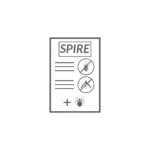
Same Day* Service! Free Inspections Hornet Control
Spire Pest Control’s Hornet Control
Exterminator Service
If you’ve ever been stung by a hornet, you know it’s an extremely painful experience. Some people will only have an itchy bump for a few days, but for others a hornet sting can be life threatening. Hornets will build their nests in yards and under eaves, causing concern to homeowners. Hornets are passive creatures when away from their nests, but they have a reputation for being aggressive towards humans. The fact of the matter is that hornets are only aggressive when disturbed or feel like their colony is being threatened. For this reason, it’s best practice to hire an exterminator to properly dispose of nests around your home. At Spire, we want to help you get rid of hornets so you can feel safe and comfortable in your own yard.
If you’re having problems with Bees, Wasps, or Yellowjackets, check out these pages for more info.
Signs of an Hornet Control
Infestation
You might already know for sure that you have a hornet problem. But here are a couple of the most common signs of a hornet infestation.
Flying Hornets
You might see one flying around the house, yard, or garden.
Visible Hornet’s Nests
These are always physical nests built above the ground, usually in trees or on soffits. They can range in size from a golf ball to a basketball.
Hidden Nests
Some types of wasps make nests underground, underneath house siding, or in gutters. You’ll know you have hornets (or another type of wasps) if you see them flying in and out of specific places on or around your home.
What You Need to Know About Hornet Control
- Hornets are a large type of stinging wasp that come in all different colors. These pests can be:
- Black
- Orange
- Dark yellow
- Dark red
- Up to one inch or larger in length
- Very aggressive and prone to stinging
- Hornets are very territorial and are liable to sting if you enter what they deem their space.
- These flying pests can be beneficial in some cases because they mainly eat other insects. This could help reduce the amount of other pests you see on your property. However, most would argue that the immediate threat hornets pose to you and your family outweighs any benefits.
- Like other wasps, hornets love to eat sugar and sap, but are also very good at controlling garden insect populations.
Helpful Hornet Control Prevention Tips
Make or purchase Hornet Decoys to hang in areas where hornets nest.
Limit food access by covering trash cans and food.
Ensure all door and window screens are in good repair.
Don’t leave uncovered food outside.
How Do I Get Rid Of Bed Bugs?

Step 1: Schedule
Call (888) 316-3615 for a free bed bug treatment quote and a timely appointment with skilled technicians. No obligation to proceed.

Step 2: Treatment
A certified technician will conduct a thorough bed bug inspection of your home to provide a customized treatment plan.

Step 3: Follow Up
We provide a detailed report of the service and helpful recommendations. For maximum effectiveness, receive a follow-up treatment 14 days after treatment.

Satisfaction Guaranteed!
We guarantee you won’t see bed bugs for 30 days. If you do, we will come back and treat again for free.
Call to Get a Quote or to Schedule Same Day* Service
Hornet Control FAQ
Hornets are extremely tough insects, and they’re difficult to keep away from your home when you’re trying to do it alone.Spire Pest Control is here so you don’t have to feel alone. Whether the hornets are building nests in your eaves and soffits, in the siding of the house, in a tree, or in the ground, we have the tools to keep you safe. Our treatments will get rid of wasps for you and make your home safe and comfortable again.
Some people are allergic to hornet stings. When stung, they are at risk to go into anaphylaxis, which is life-threatening.
For most people, stinging insects like hornets don’t usually cause more than a painful welt and some swelling. However, too many stings could cause life-threatening reactions. Better safe than sorry, callSpire Pest Control to get rid of hornets!
Like many other stinging wasps, hornets can sting you multiple times because their stinger is straight. By contract, honey bees have a barbed stinger, they can only sting once and then die.
In general, hornets eat crop-destroying insects and insect pests, which makes them beneficial in the wild.
Some hornets contribute to plant pollination the way honey bees do, although no hornets are as effective at plant pollination as native bees.
Some species of hornets also eat flower nectar and pollen, just like bees, which means some hornets help plants by pollination. Although, no pollinating insects are quite as efficient pollinators as native bees.
Most hornets only eat meat and other insects. However, there are some types of hornets that also eat flower nectar and pollen.
Some hornet species can make a small amount of honey that they regurgitate for their larvae to eat. However, they don’t collect pollen the way honey bees do.
Wasps. A wasp is a general group of flying, stinging insects that eat meat, can sting multiple times, and are either solitary or make colonies. This means that hornets, yellowjackets, mud daubers, and paper wasps are all types of the general “wasp” group.
Bees. All bees are hairy and have short wings. They can either be yellow and black or entirely black. Bees are neither bumblebees or wasps. Of the thousands of types of bees, carpenter bees and honey bees are the most common.
Bumblebees. All bumblebees are closely related to wasps, but they are neither bees nor wasps. They have stubby wings and fat, hairy bodies that are black and yellow. They often make small colonies underground.
Asian giant hornets are a very large hornet that lives in colonies. They usually kill colonies of honey bees all at once in order to eat their larvae.
They can grow to about 2 inches long, with yellow heads and either yellow-and-black stripes or yellow-and-brown stripes on their abdomen.
As of December 2019, Asian giant hornets, Vespa mandarinia, were spotted in Washington State. Their native range is mainly in the eastern parts of Asia, so they don’t belong in the U.S. That makes them an “invasive species.”
Asian giant hornets can be very aggressive if you mess with their nest, but contrary to their “murder hornet” name, they won’t come after you like killer bees do.
Contrary to their nickname, Asian giant hornets are not usually aggressive and don’t go after people unless you handle them or threaten their nest. But their sting can be deadly if enough of them sting you, especially for those allergic to wasp stings. Globally, up to a few dozen people die from these wasps every year.
The main difference is in size, though there are differences in coloration.
Asian giant hornets are about 2 inches long, and they have a yellow head with yellow and black or yellow and brown stripes on its abdomen.
Cicada killers are usually 1.5 inches long, and they are black or dark brown with yellow stripes and a dark-colored head. Cicada killers are solitary.
European hornets are between 3/4 and 1.5 inches long. They are usually brown with yellow stripes and a pale color on their heads.
The way you can clearly identify them is that the Asian giant hornet is huge! It’s the biggest known wasp species, measuring around 1.5 – 2 inches in length for the worker wasps. The Asian giant hornet also has a unique color pattern. It’s head is completely yellow, and its abdomen has either yellow and black or yellow and brown stripes.
Even though the mainstream media has labeled these hornets as “murder hornets,” in reality these wasps don’t go rampaging and killing people as the name suggests.
Sadly, these wasps are murderous against honey bees. A few Asian giant wasps are capable of completely slaughtering a honey bee colony of 30,000 to 50,000 individuals in just a span of a few hours!
If you think you may have come across the Asian giant wasp, don’t hesitate to call your state department of entomology extension office to confirm the identification.
Count on Spire Pest Control for Comfort and Safety
To ensure our customer's safety, we insist on a thorough screening process for all Spire Pest Control Technicians. They also complete extensive training in the classroom and on the job with an experienced mentor before servicing alone.
See photos of our team by visiting the Meet Our Team page for your branch.

Money Back Guarantee
If a Spire Pest Control customer has an infestation of covered pests in their home or business between regularly scheduled Home Protection Plan treatments, we will come back and perform targeted treatments to get rid of the pest at no charge. If Spire Pest Control cannot resolve the problem after three such targeted treatments, we will cheerfully refund the customer’s last monthly subscription fee, as long as all other terms of the agreement have been met.
And if you see any pest activity between your regularly scheduled treatments, simply give our office a call; we'll come back at no additional charge.


